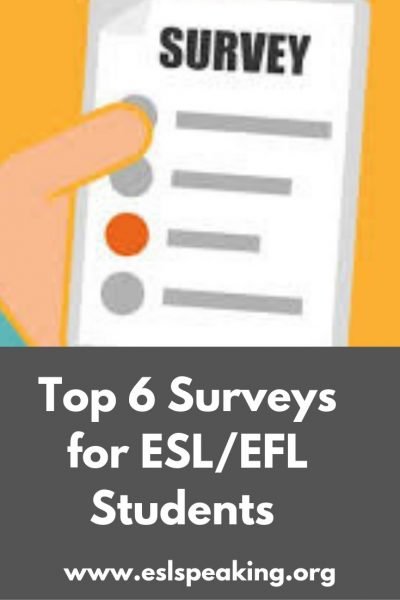Are you looking for the ultimate 4-skills ESL activity that you can use with just about any level of student? Then you’re for sure going to want to stay right here to find out more about ESL questionnaires and ESL surveys to try out with your students.

ESL Survey and Questionnaire Ideas
You’re certainly in the right place. Keep on reading for some information about ESL surveys, why I love them so much and then links to six of them that I’ve created for my students.
Yes, it’s basically everything you need to get yourself some ESL awesome in your classes today. Of course, it’s certainly possible to design you own surveys in a few minutes with just about any grammatical point or vocabulary set, including something like the months of the year.
Why Use ESL Questionnaires?
You’ve probably made your way here because you’re searching for ESL survey ideas. We’ll get to that, but first I’ll tell you why I love survey ideas for students so much. I’m convinced that every ESL teacher should be using them every single month in all their classes.
Surveys are one of my favourite ESL activities. If you ask my students, they’ll probably tell you the same thing. I use them at least once a month in all my classes, for a huge variety of topics. In particular, they work well for an icebreaker activity on the first day of class.
They can also be used for just about any level, with the exception of the absolute beginner. Good reading skills and the ability to ask and answer basic questions are the minimum skills required for ESL students’ surveys.
ESL Survey Ideas
If you’re looking for ESL survey ideas, you’ve come to the right place! Here are six ESL-speaking surveys that I’ve used in my own classes over the years.
I designed them to be used for students in South Korean universities. However, these ESL survey questions could be used by most teachers around the world with just a little bit of modification.
Of course, don’t be afraid to branch out and make your own surveys for the unit you’re working on. It really is quite easy and should take you just a few minutes.
Be sure to do it in Google Drive so that you can recycle it from year to year. Even if you change textbooks, many of the topics and grammar points are the same.
ESL Survey for Students: Ideas for Kids, Teenagers and Adults
Kids and teenagers love surveys as well, but you’ll have to set up the guidelines pretty carefully. For example, mention that students are to only speak 1-1 with a partner and not in a big group. The goal is to have interesting conversations, not finish the activity as quickly as possible.
I find that if I don’t set these rules up in advance, it’s usually just a free-for-all, without much real value.
Enjoy these interesting, and engaging ESL survey questions! Clicking the links will take you to the PDF file on this website where you can download and print them.
Healthy Eating Survey (More ideas here: ESL Health Games.)
Have You Ever Survey
Around the House Survey
Celebration Survey
Dependent Clause Survey
Check out the dependent clause survey for an example of how to use surveys to practice new grammar.
More ESL surveys for students here.
What about an ESL Introductions Survey?
This is an excellent ESL Speaking Activity to do on the first or second day of class as a way for students to get to know each other. Here are a few of the reasons why I like to do an introduction survey with my ESL/EFL students:
- It breaks the ice between students if they don’t already know each other
- It sets the tone for the rest of the semester (students have to get up, out of their seats and talking in English to everybody)
- This ESL survey is a non-threatening way to get students talking. They only have to talk to one other person, and not in front of the whole class
- Students can also talk to the teacher during this ESL introduction survey.
- You can find out if anyone in your class has something unusual about them (an interesting part-time job, a twin, comes from a different city, etc.).
- It helps everyone get to know each other’s names.
- They’re ideal for mixed-level ESL classes.
How this ESL Introduction Survey Works
I get the students to stand up and they have to move around the class talking to as many people as possible in the assigned amount of time (around 15 minutes). Here are a few of the ground rules I set up:
- Only talking 1-1. It’s not a group activity
- The goal is to speak in English. You could do it in your first language, but it’s a waste of time
- It doesn’t matter if you finish or not, just try to have an interesting conversation with lots of your classmates
- You have to ask a follow-up question. Remember how to do that???
If Someone Says Yes
The way it works is that students have to find someone who answers yes to a question. If they say yes, they can ask a follow-up question or two. Then, they fill in the chart quickly with the answers. Students don’t have to write full sentences, but they can just jot down a note or two.
If Someone Says No
If a student says no, you don’t write anything on the survey paper. Just ask another question from the survey. I always leave a couple of blank spaces on my surveys for students to make up a question or two on their own, if they’re having a hard time finding a yes for someone.
Do Some Examples First with your Introduction Survey
This introduction survey can be a bit difficult to explain, so it’s best to do two examples before you start. The first one is where you ask a student a question and another where the student ask you a question.
Check out this ESL Introducing Survey Here:
Here’s the introduction survey I use in my own classes. You can really easily make your own in 5 minutes or less.
Adapt the questions to suit your level of students. Of course, students in middle school probably wouldn’t have a part-time job, or live away from their parents.
What do you think about this first-day student survey? A winner, or would you adapt it in some way for your students? Leave a comment below and let us know what you think.

ESL questionnaires
Teach Business English? Here’s a Survey Idea for your Students
If you teach business English or more advanced students, you can get them to do a more traditional kind of survey. They can think of a question or set of questions related to a topic where people might have various opinions. For example:
- Subsidies for farmers who produce meat or dairy products
- Increased taxes on cigarette prices
- Basic universal income
I get students to work in pairs, and then come up with a few questions related to their topic (check and make sure nobody is doing the same one before you get to this stage), as well as some possible follow-up questions. But, they’re free to let the conversation go where it goes.
Then, I get the students to find out what some of the other people in the class think. They have to stand up and walk around to do this.
One person is the interviewer and their partner writes down some notes about the answers. This usually takes 15-20 minutes depending on the size of the class.
It works best if students talk to at least 6 other people.
Then, students look at the answers they got, find some patterns and report to the class their findings about the topic.
Students generally love this activity, so try it out for your more advanced students at least once a semester.
Don’t Forget to Give Feedback for your Survey Activity
Also, be sure to give feedback to your students about how the activity went so the class can improve for next time For example, you could say:
- I saw many people talking in big groups. Remember that most of the activities in this class are for 1-1 talking.
- It seemed like many of you found it quite difficult to ask follow-up questions. Let’s review this quickly…
- When I checked your papers, I noticed that some students were writing in Korean. Remember that you’re here to practice English so please work on that! You’re already a pro at Korean writing.
Have you Ever Survey Ideas
If you want to come up with a fun, “Have you ever. . . ?” survey for your students, here are some questions to consider including:
- Have you ever travelled to another country? If yes, where did you go?
- Have you ever tried a food from a different culture? What was it?
- Have you ever met a famous person? Who was it?
- Have you ever participated in a sports event? Which one?
- Have you ever performed on stage? What was the occasion?
- Have you ever volunteered for a charity or organization? Which one?
- Have you ever ridden a horse? Where and when?
- Have you ever read a book in English? What was the title?
- Have you ever cooked a meal for your family or friends? What did you make?
- Have you ever gone camping? Where did you camp?
- Have you ever learned to play a musical instrument? Which one?
- Have you ever taken a dance class? What style of dance?
- Have you ever visited a museum? Which one?
- Have you ever gone swimming in the ocean? Where?
- Have you ever climbed a mountain or a hill? Which one?
- Have you ever ridden a bike for a long distance? Where did you go?
- Have you ever seen a live performance, like a play or a concert? What was it?
- Have you ever been to a wedding? Whose wedding was it?
- Have you ever taken a language course? Which language?
- Have you ever tried a new hobby? What was it?
Why Use Surveys for English Classes? Top 5 Reasons
I use them at least once a month in basically all my classes. Here are some of the reasons why you’ll want to try them out.
#1: They are Student-Centred
The goal of most ESL teachers is to have a student-centred classroom. This means that the students are doing most of the work, instead of you! Students are reading, talking, listening, writing, and thinking while you’re mostly facilitating.
Surveys for ESL students are very student-centred- I actually can’t think of an activity that is more so.
#2: They Practice both Questions and Answers
Does this sound familiar? The teachers asks a question and the students give an answer. Surveys for ESL students are great because they get students practicing both questions and answers.
In a traditional teacher-centred classroom, students often don’t get much of a chance to practice asking questions because the teacher does the asking and students do the answering. ESL surveys also encourage active listening-follow up questions require students to listen carefully to their partners’ answers.
#3: Fun Surveys are Perfect for Sleepy and Bored Classes
Another great thing about them is that they get students up and out of their seats. The students have to mingle and try to talk to at least 10-15 of their classmates, depending on the length of your survey.
Try them out on a Friday afternoon when your students are tired and not behaving well, and you’ll find that it helps them to focus on English. Use them on a Monday morning when the students are sleepy and they’ll be able to speak English!
#4: An Excellent 4-Skills Activity
Finally, I love them because they are a 4-Skills activity. Students have to read the questions, ask the questions, answer the questions and finally take a few notes about the answers. Reading, writing, listening and speaking are all covered in this ESL activity.
This imitates the real world where students usually don’t focus on any one single activity at a time in isolation. They’re doing all four, often within just seconds or minutes of each other. It’s my goal to replicate the real world in my classroom as much as possible, which is why 4-skills ESL activities are so important. Try to use them as much as possible!
#5: Students can Learn Interesting Things about their Classmates
The final reason I like to use ESL surveys for students is that they help them learn interesting things about their classmates. For example, who has a part-time job, a twin or more than 1 sibling are just some of the cool stuff that can be uncovered, depending on the questions you put on your survey.
Did you like these ESL Questionnaires?
- Amazon Kindle Edition
- Bolen, Jackie (Author)
- English (Publication Language)
- 187 Pages - 03/09/2016 (Publication Date)
Yes? Thought so. Then you’re going to love this book over on Amazon: 101 ESL Speaking Activities for Teenagers and Adults. The key to better English classes is a wide variety of interesting, engaging, and student-centred activities including survey activities. This book will certainly help you get there in style.
We recommend keeping a copy of the book on the shelf in your office to use as a handy reference guide. Or, consider taking the digital version with you on your phone, tablet, or laptop to your favourite coffee shop for some serious lesson planning.
It really is that easy to have better English classes! Check out the book for yourself but only if you want to level up your teaching game in a big way:
Survey Activity FAQs
There are a number of common questions that people have about using questionnaires in their English classes. Here are the answers to some of the most popular ones.
What Skills do ESL Surveys Cover?
ESL surveys are ideal because they can cover a range of skills in a single activity. Although they’re heavy on the speaking and listening, they do involve some writing if students take notes on answers or write their own questions. Students also have to read the questions, so they are one of the best 4-skills ESL activities.
Are ESL Questionnaires a Communicative Activity?
ESL questionnaires are one of the best communicative activities for language learners because students have to talk to the other students in the class to find answers to their questions. They’re also ideal to use as an icebreaker to help students get to know each other.
What Should I Do After the ESL Questionnaire?
After the activity, be sure to elicit some answers from the class about the most interesting things they learned about their classmates. I find that students in Korea are a little bit shy about sharing some of these things so I have to give them a bit of encouragement.
For example, I’ll ask if they found someone who had a part-time job. Or, if there’s anyone in the class who is a twin (I myself am a twin, and students love knowing this for some reason!).
If it’s not the first day of class and we’re using the icebreaker survey, I’ll usually let students know my overall rating of how the activity went. For example: excellent, or room for improvement. I’ll say things like:
- I loved how so many students were speaking English 1-1
- Some nice follow-up questions
- Remember that the goal is to speak English, not get something like this finished as quickly as possible
- If you don’t know a word, try using some other way to explain it instead of just getting out your cell-phone dictionary
What Topics Can I Use for ESL Surveys?
In reality, you can make an ESL survey for students that covers just about any topic. However, they’re commonly used as an icebreaker activity. Some other topics include sports, hobbies, daily schedules, food, travel and more.
Have your Say about these ESL Surveys!
What do you think about using surveys in your English classes? Leave a comment below and let us know what you think. We’d love to hear from you.
Do you make your own, or borrow from someone else? Be sure to share your secrets with us!

ESL survey ideas
Last update on 2025-04-17 / Affiliate links / Images from Amazon Product Advertising API







